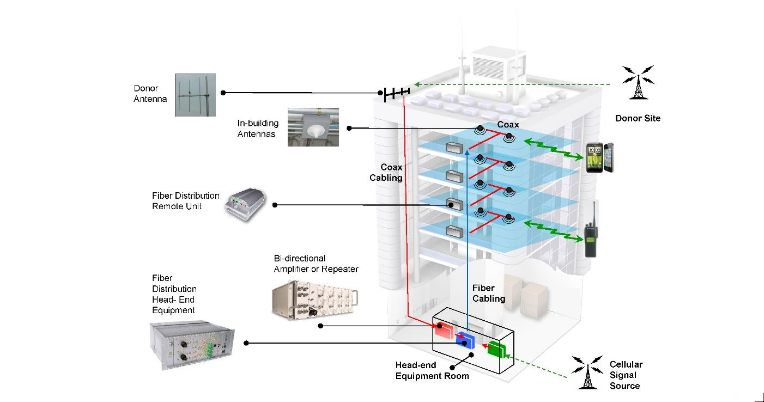Are You Code Compliant? New LAFD Mandates for Emergency Responder Radio Coverage Systems in Buildings

This article will cover everything you need to know about ERRCS and the new codes adopted by the L.A. Fire Department that impact commercial properties.
Watch the video version of this content.
Setting the Stage
Before we dig in, it's important to start with what ERRCS is and why we need it. ERRCS stands for Emergency Responder Radio Coverage System, also known as Public-Safety or First-Responder Systems / DAS (Distributed Antenna System).
We all know the dependency today's culture has on wireless devices. 500,000 E911 calls are made each day. According to the FCC, 80% of E911 calls are made from wireless phones. A report showed that around 80% of cellular calls originate or end inside buildings.
What does this mean for building owners and managers? Basically, when putting together a comprehensive public safety plan for your property, you should consider coverage for both first responder radios as well as cellular devices.
Ask yourself: Does my property have sufficient coverage inside to initiate and complete these calls?
Background: Why is ERRCS Necessary?
The need for Public Safety DAS first came on the radar in 2001, after the 9/11 terrorist attacks. As our brave first responders rushed into the World Trade Center to do what they were trained to do, they were unable to communicate with their teammates outside with their two-way radios. This was due to the fortified construction of the building. Steel and concrete limit the signal penetration.
This resulted in being unable to warn them that the buildings were collapsing, and unfortunately, we lost many first responders as well as many civilians on that day. Since then, it's been an initiative of many municipalities across the country to adopt codes that will ensure wireless coverage is available within buildings to support first-responder communications specifically.
LAFD New Codes
As of August 7th, 2018, a new language has been adopted by the L.A. Fire Department, and they've tightened enforcement of these codes. There's a lot of buzz surrounding enforcement of mandatory public safety systems in buildings in the city of L.A. Many developers and construction companies have been caught off guard and are unable to get their certificate of occupancy on new developments because they made no provision for an Emergency Responder System and don't pass the signal test.
Just three years ago, this was not a requirement to get a CO. Make no mistake about it; the L.A. Fire Department has taken enforcement to a new level.
NFPA 72 and NFPA 1221 have set the standards of the code, but each AHJ has its own augmentation and interpretations of the code.
ERRCS Requirements:
Here is a list of the system requirements:
- You need 99% coverage in critical areas, including the command center, elevator lobbies, and exit stairs
- 90% coverage for remaining areas
- Component and closures must be in NEMA-rated enclosures
- Repeater equipment shall be FCC-approved and certified
- The UPS requirements are:
- Primary is dedicated branch circuit
- Secondary is 12-hour battery backup
- Annual testing is required for active components and the system
Does This Apply to My Building?
The next question you may be asking is, "Does this apply to me?" In L.A., you need an ERRCS if your property meets or exceeds any of the following:
- There are more than three stories above grade plane
- The total building area is 50,000 square feet or more
- The total basement area is 10,000 square feet or more
- If any basement or lower level extends two or more stories below grade plane
How Can I Make Sure I Am Code-Compliant?
So you may be asking, "How can I make sure I'm meeting these requirements?" It's simple. Have the right solution and choose an experienced wireless integrator who has a proven track record of complying with the local AHJ.
- Choosing the right system
To the first point, there are two types of systems that can enhance your in-building wireless coverage. Both are called Distributed Antenna Systems, or DAS. The first is an ERRCS DAS solution. It's used strictly by emergency responders: police, fire, and ambulance. The other type is a cellular DAS solution, which is used by the general public for talk, text, email, web browsing, etc.
Essentially, a Public Safety DAS retransmits fire or public radio frequencies from outside a building, where the signal is presumably stronger, into the building, where it's usually weaker or non-existent.
Here is a technical overview of DAS solution architecture and how it works

Here's a standard building layout with the head-end equipment room located somewhere inside the building.
You'll have a donor site usually located somewhere within a few miles of the building. You have the donor antenna on the rooftop, which captures the signal and transmits it to the head-end equipment. The signal is then amplified through some type of repeater and then distributed throughout the inside of the building, which then feeds the mobile devices.
- Partnering with a knowledgeable integrator
Now that you have a broad understanding of the type of technologies needed for public safety communications, the following recommendation is to choose the right wireless integrator who can provide you consultation for specifics of the solution that is needed for your building and implement that solution.
Whomever you select should:
- Have technical expertise (with references), including design knowledge and OEM recommendations
- Have a compliance perspective. They should:
- Understand the local AHJ requirements: An experienced vendor will know how to design and construct the system to meet the local code requirements.
- Be able to walk you through the process step-by-step: They should walk you through the decisions that need to be made through the process and provide recommendations based on the unique needs of your property, etc.
Overcoming Obstacles:
- The main challenge of a Public Safety DAS is that it can be an expensive solution depending on the city code requirements. For example, some jurisdictions require fire wrap and conduit all the way to the antenna, which drives up the cost of the system.
- Another challenge is that every county has its own set of code requirements. So it's important that providers work diligently with the residing jurisdiction, also known as the AHJ, the Authority Having Jurisdiction, to ensure that all design requirements are being met before the installation of the public safety network. This is usually the city fire chief.
Connectivity Wireless for Public Safety Systems
Connectivity Wireless is a full-service wireless solutions provider and a trusted Public Safety system integrator. We are happy to provide you with more information if you'd like to know more about how the new codes could impact your property or are interested in implementing a solution for your building.
With extensive in-building wireless experience in L.A. locations as varied as the Wilshire Grand Center (check out our video case study), The Grand LA, Martin Luther King Hospital, San Diego Convention Center, Children's Hospital of Orange County, and Angel Stadium, we can equip you with 4G/5G, private networks, Wi-Fi, analytics solutions, and public safety solutions to best fit your connectivity and business needs.
Contact us today!
Shane Morgan
478 256-4111
[email protected]
This guest blog post was provided by Shane Morgan, Connectivity Wireless. Visit Connectivity Wireless to learn more about their services.


